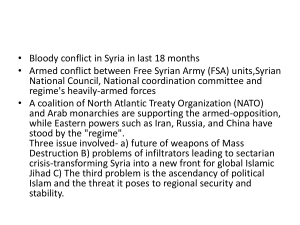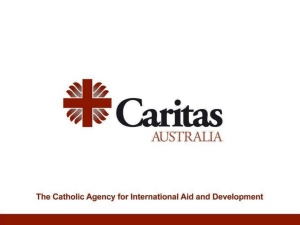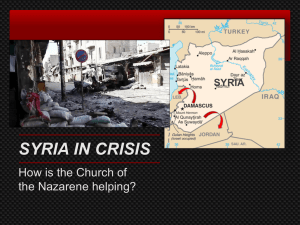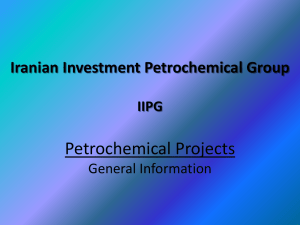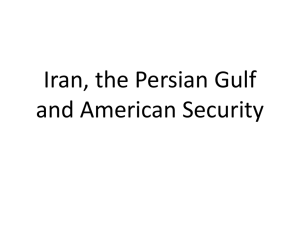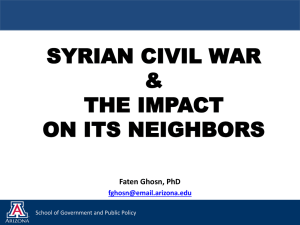Jubin Goodarzi - Iran`s Strategy in the Levant
advertisement
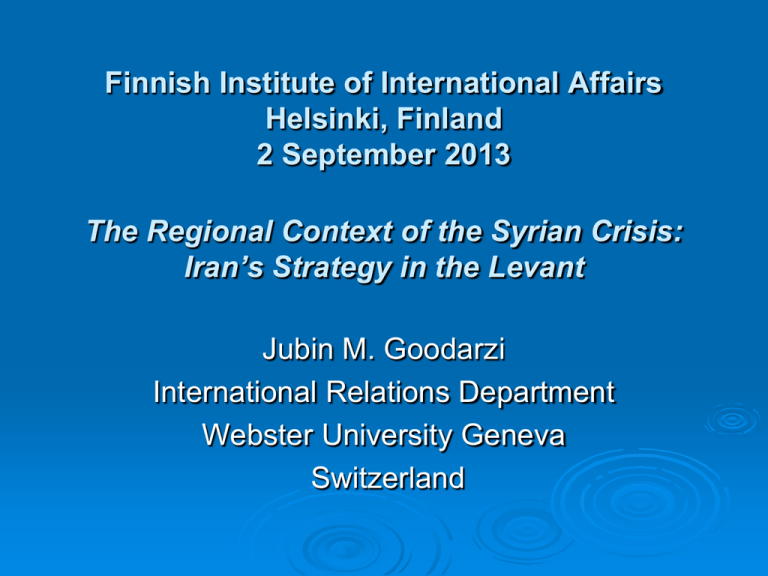
Finnish Institute of International Affairs Helsinki, Finland 2 September 2013 The Regional Context of the Syrian Crisis: Iran’s Strategy in the Levant Jubin M. Goodarzi International Relations Department Webster University Geneva Switzerland Iran and Syria Notable Quotes “The chain of resistance against Israel by Iran, Syria, Hezbollah, the new Iraqi government and Hamas passes through the Syrian highway. Syria is the golden ring of the chain of resistance against Israel.” Ali Akbar Velayati, Senior Advisor for Foreign Affairs to Iran’s Supreme Leader. 6 January 2012 “What is happening in Syria is not an internal issue, but a conflict between the axis of resistance and its enemies in the region and the world. Iran will not tolerate, in any form, the breaking of the axis of resistance, of which Syria is an intrinsic part.” Saeed Jalili, Head of Iran’s Supreme National Security Council. 6 August 2012 Syria’s Importance to Iran (1979 to Present) Most Important & Only Longstanding Arab Ally 2. Provides Tehran with Access to the Levant & the Arab-Israeli Arena 3. Serves as a Major Conduit for Iranian Arms and Assistance to Hezbollah in Lebanon 4. Enduring Example of Arab-Iranian Cooperation on Several Important Levels (Political, Economic, Strategic/Military, Intelligence, Ideological, Etc.) 1. Iran and Syria The Seven Stages in the Evolution of the Alliance Between Iran and Syria – 1979 to Present 1. 2. 3. 4. 5. 6. 7. The Emergence of the Iranian-Syrian Alliance 1979-82 The Zenith & Limits of Iranian-Syrian Power 1982-85 Intra-Alliance Tensions & Consolidation of the Axis 1985-88 The Containment of Saddam's Iraq in the Levant & Gulf 1988-91 Alliance Cooperation in the Post-Cold War Era 1991-2003 The Reinvigoration of the Alliance after the Iraq War 2003-11 The Syrian Civil War and Iran’s Involvement 2011-Present Iranian and Syrian Foreign Policy Priorities Arab Interests (Syria) Islamic Interests (Iran) National Security Regime Survival The Evolution of the Power Structure in the Iranian-Syrian Alliance (1979 to Present) 1980s 1990s 2000s Syria – The Dominant Partner Due to: Transition Iran – The Dominant Partner Due to: Syrian Military Presence in Lebanon (since 1976) Syrian Military Withdrawal from Lebanon (2005) Syria's Political Prominence due to Egypt's Banishment from the Arab Fold (1979-87) & Iraq's Entanglement in the Gulf War (1980-88) Soviet political, military & economic support for Syria Collapse of the Soviet Union (1991) Syria Conduit for Arms Shipments to Iran Arms Embargo on Iran (US-led Operation Staunch since 1983) Iran Finances Syria's Foreign Arms Purchases Development of Indigenous Iranian Arms Industry Iranian Military Exports to Syria Iranian Oil Shipments to Syria (19821989) Iran at War with Iraq (1980-88) Iran's Isolation in the Arab World, Alliance with Syria to Dispel ArabIranian Rift Iran Mends Fences with Many Arab States after Eruption of Kuwait Crisis Iran's Political Posturing on the Nuclear Issue (2003-Present) Prominence of pro-Iranian Hezbollah on Lebanese Political Scene (since 2000 & 2005) US overstretched in Iraq & Afghanistan (Iran's Neighbors) Iran Reaping Political & Economic Advantages of High Oil Prices Iran and Syria The Outbreak of the Syrian Crisis To Support or Not to Support? Iran Faces Hobson’s Choice: 1. Support Assad and Face the Consequences 2. Withhold Support and Hope that a New Syrian Regime Will Be a Friend of the Islamic Republic Iran’s Support for Damascus 1. 2. 3. 4. 5. 6. 7. Crowd Control Equipment & Technical Aid Guidance/Assistance on Monitoring the Internet & Mobile Telephone Network Financial Resources Arms & Ammunition (i.e. via Iraq) Oil Shipments (via sea) Provide Personnel & Specialist Units Train the National Defense Army The Evolving Nature of Iran’s Position Since the Outbreak of the Syria Crisis 1. 2. 3. 4. 5. Steadfast Support for Damascus (Spring 2011) Growing Doubts & Negotiations with the Syrian Opposition (Summer 2011) Emergence of a Proxy War & Stalwart Support for Assad Regime (Autumn 2011 & Winter of 2011/12) Support for Multilateral Negotiations Mediated by the UN/AL (Spring & Summer 2012) Continued Backing for Damascus and Exploring Other Options & Exit Strategies (Autumn 2012 to Present) Other Motivations for Supporting Damascus “Defensive” Considerations: 1. Thwart the Dismantling of the “Axis of Resistance” 2. Prevent Regime Change in Syria and Iran 3. Syria is the “First Line of Defense” Against Foes 4. Contain the Crisis in Order to Avoid Spillover into Lebanon and Iraq in Particular. 5. The “Mother of All Nightmares” – Regime Change in Syria and Iraq Possible Future Scenarios 1. 2. 3. 4. The Survival of a Weakened Assad Regime in Syria or Part of the Country Regime Collapse & Continued Civil Strife & Instability in Post-Assad Era The Emergence of a Secular or Sunni Islamist Regime in Damascus Continued Conflict & a Negotiated Settlement / Political Transition A Political Solution to the Syrian Conflict With Iranian Involvement? 1. 2. 3. 4. 5. 6. Incentives for a Negotiated Settlement: Contain the Damage & Cut Losses – the Pre-March 2011 Political Status Quo Ante Cannot Be Restored. Prevent the Dissolution of Syria and Spillover of Conflict into Neighboring States (Lebanon and Iraq). Demonstrate Iran’s Importance as a Key Regional Actor to Reach a Diplomatic Solution. Avoid Further Polarization and Total Transformation of the Conflict into a Regional Sectarian War (Sunni vs. Shia). Facilitate the Emergence of a National Unity Government in Damascus that is Not Hostile to Tehran. Iran Cannot Indefinitely Provide Support to Assad in View of its Own Domestic Woes and Foreign Sanctions.
